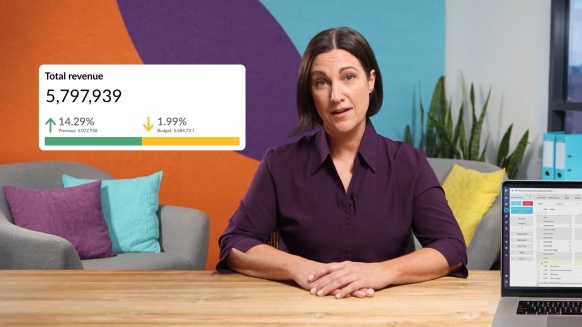Financial data visualizations - how they help businesspeople communicate

Humans are hard wired to love pictures over written content. It’s why you’ll often gain a better response from stakeholders when data visualization techniques such as dashboards, bar charts, graphs, infographics and videos are used over spreadsheets.
To make strategic decisions using spreadsheets, the finance team has to pore over thousands of rows of raw data. Manually analyzing company data this way is laborious, becoming a chore that is often neglected. However, when the same financial data is consolidated using business intelligence data analytics and presented in a visual format —it’s easier to analyze and communicate your insights with the wider business.
What are financial data visualizations?
Financial data visualizations involve the visual representation of all information in the balance sheet, profit and loss (income statement) and cashflow statements so the finance team can easily analyze the information and share the trends, exceptions and opportunities. Financial data visualizations transform static month-end statements into a more meaningful story that more people in a business can see and understand.
Common types of visualizations
Line charts are ideal for showing trends or changes over time by connecting data points with a continuous line. They are especially useful for visualizing patterns in sequential data, such as sales growth or temperature variations.
Bar charts compare categorical data by representing values as rectangular bars, making it easy to identify differences at a glance. They are versatile and can display data horizontally or vertically for clearer interpretation based on the dataset.
Scatter plots reveal relationships or correlations between two variables by plotting data as individual points on a graph. They are helpful for identifying trends, clusters, or outliers in datasets, such as sales performance relative to marketing spend.
Heatmaps use color gradients to represent data intensity or frequency, offering a quick way to spot trends or anomalies across dimensions. They are often used for analyzing large datasets, like website traffic or product demand across regions.
Dashboards integrate multiple visualizations into a single interface, providing a real-time snapshot of key performance indicators (KPIs). They allow users to monitor and analyze data from different sources in one place for better decision-making.
Why are financial data visualizations useful?
To forecast organizational performance and track variations against budgeted figures, finance professionals have numerous sources to collect in-depth data. However, finance faces two major problems in analyzing data and collecting insights:
- Data is spread across multiple sources so manual interpretation becomes a daunting task.
- Processed data has to be communicated effectively so people can easily understand data insights and use them to improve the decision-making process.
Data visualization lets the finance team convert complex data into smaller chunks and static figures into compelling stories that others can better understand and consume.
With data visualization, finance professionals can easily communicate the financial performance to other people in the organization or educate the rest of the team to look out for certain events, such as when indicators are dropping like the threshold for profit margins. Visual representation in the form of dashboards, bar charts, graphs, maps, and other graphics enhance understanding and help people make better decisions that are driven by data, not ‘gut instinct’.
Data visualization also puts endless rows and columns of data, available in multiple sources, on one screen, making it easier for the finance team and others to comprehend.
With the help of the data visualization tools, the finance team can build financial dashboards for visual comparison and analysis of KPIs. Depending on your data visualization software provider, dashboard functionality should include the ability to drill down into the data and see a wide variety of results on a single page.
Users can swiftly comprehend and measure data accurately, and in real-time, without affecting the general ledger. Below are some examples of the dashboards that finance teams can build to communicate data insights to other people in the organization so they can understand the impact of their decisions on financial performance:
- Cash Management Dashboard;
- Financial KPI Dashboard;
- Profit and Loss Dashboard;
- CFO Dashboard; and
- Financial Performance Dashboard
How can Phocas help with financial dashboards?
Phocas pulls data from your ERP and other types of data sources into one platform, so everyone has access to one set of up-to-date numbers. With its human-friendly interface, it’s easy to create and customize unlimited dashboards that provide a real-time holistic view of financials. The finance team can perform in-depth data analysis with the ability to freely explore any variable, pivot the data, and drill down to transactional level.
Check out our ultimate guide to Financial software, budgeting and analysis
With Phocas doing all the heavy data lifting, the finance team are freed from manually collecting data and filling spreadsheets. Its BI foundation also provides the ability to show financial information alongside other business metrics.
Live dashboards present a snapshot view of financial performance. Users can analyze and track both legal and non-legal entities (branches, areas, departments, product lines, etc.) to measure financial growth.
Instead of simply visualizing data in graphs, pie charts and maps, Phocas provides an array of data visualization tools, features, and systems to give you an unparalleled experience.
You can customize data to meet your needs, present information as you want and access everything, including charts, dashboards, KPIs, data cubes, and reports inside the software.
Trade Supply Group use an Epicor Eclipse ERP system that is matched with Phocas data analytics and Phocas Financial Statements.
Scott Sokoly, Business System Administrator says “Phocas Financial Statements takes away the nightmare of producing consolidating financial statements that are broken down by branch division or consolidated for the entire company.
“The accounting department is excited because it's less work to make a consolidated financial statement. In the past, we have five Excel sheets and you basically add them together. It's just busy work for them so I think they're excited they don't have to do that anymore,” says Scott.
"Branch managers are getting reports that they just didn't get before because the accounting department didn't have time to prepare that level of report for every branch manager. All levels of our mid-management can now look into our performance, from expense analysis to margin monitoring. So I think the financial review is going to go deep into our business."
"We're able to make better decisions quicker and put information in the hands of the people who are really running our businesses day-to-day," says Scott.
Data visualization enables teams to have knowledgeable conversations about financial statements. Financial dashboards ensure that non-financial people can grasp the numbers and educate themselves about data to make informed decisions.
Phocas, as a data visualization tool, connects all pieces of the puzzle and transform business processes, thus becoming a partner to your organization’s growth and success.
To find out more about financial data visualizations, download this ebook: Turbo Charge your finance team with Data Analytics.

Lindsay is an experienced writer with a passion for translating complex content into plain language. Specializing in the software industry, she explains the importance of data access and analysis for all businesspeople, not just the data experts.

Essential KPIs every distribution company executive should measure
For mid-market leaders running a wholesale distribution business, data and business intelligence technology are crucial for monitoring financial and operational performance. However, the real value lies in how your team uses the data insights to influence decision-making.
Read more
An accurate view of your business’ finances: it’s not too hard to get
Finance teams are increasingly under pressure to provide CEOs and other executives with information related to their business’ current financial scenario — but it’s not always easy for them to do so.
Read more
Cost allocation: why precision matters
It’s a common scenario: you’re out for dinner with friends, and you've enjoyed a nice meal. Now it’s time to split the bill.
Read more
The value of integrating financial and operational data
In today’s fast-paced business world, operational efficiency and confident decision-making are key to keeping your competitive edge. However, leveraging financial and operational data to do just that is a significant challenge for many organizations.
Read more
Find out how our platform gives you the visibility you need to get more done.
Get your demo today
